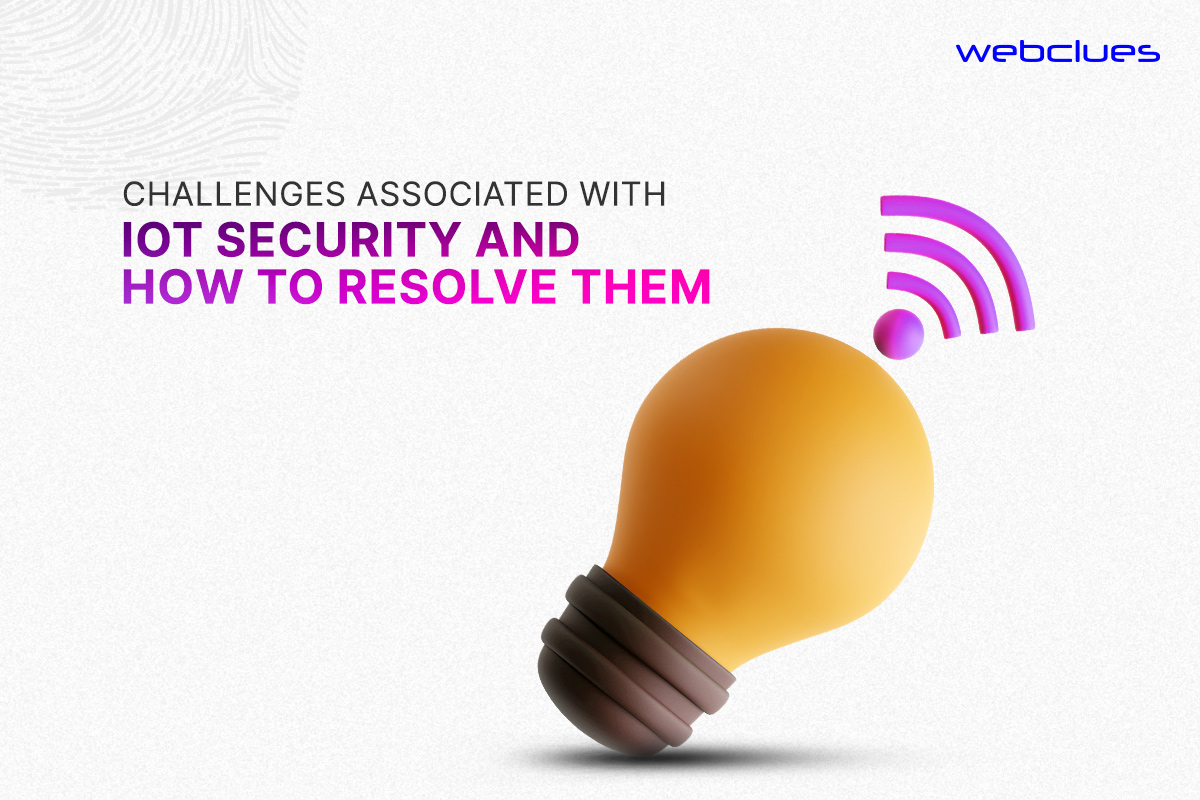17 Biggest security challenges for IoT

The Biggest Security Problems Associated with IoT and their Solutions - The Internet of Things (IoT) sector is expected to grow exponentially in the next few years, with industry experts predicting that the global market for IoT technology will reach around $1.1 trillion by 2023. IoT has revolutionized how we interact with technology and has enabled us to create more connected and smarter devices and services.
From smart homes to connected cars and wearables, IoT has been at the forefront of the most recent wave of technological innovation. IoT technology has created opportunities for businesses to collect and analyze data more efficiently, allowing them to improve the customer experience and create more personalized solutions.
A quote from an expert relating to IoT says:
"Digital transformation is about becoming 'digital first' and data-driven. The IoT is ultimately the provider of that data."
Steffen Sorrell, Principal Analyst at Juniper Research.
As per Statista, the worldwide revenue of IoT devices rose from approximately $700 billion in 2018 to $1 trillion this year. This shows how prominent IoT services are going to be in the future world.
IoT has created more efficient ways of gathering and sharing data, allowing us to develop more accurate and effective services. By connecting devices and services, IoT allows us to gain insights faster, helping us to make more informed decisions. Let us get down to the core part of the discussion, and see security challenges related to IoT with measures to overcome the same.
Challenges associated with IoT Security and how to Resolve them

Here in, is the list of problems and solutions, regarding IoT Security, and resolutions brought about by an IoT app development company in solving the same:
Problem: One of the most pressing issues with the Internet of Things (IoT) devices is the lack of built-in security. Many devices are designed with functionality in mind, and security is often an afterthought. This means that they may contain weak passwords, unsecured communication protocols, and other vulnerabilities that can be easily exploited by malicious attackers.
To address this issue, manufacturers need to prioritize security in the design and development of their devices. This includes using robust encryption, implementing secure communication protocols, and ensuring that devices are regularly updated with security patches.
Problem: Another major concern with IoT devices is their vulnerability to cyber attacks. As many of these devices are connected to the internet, they can be accessed remotely by malicious actors. If a device is compromised, the attacker could potentially use it to gain access to other devices on the same network or even launch attacks on other networks. This poses a serious risk to the security of businesses and organizations and must be taken seriously.
To ensure the safety of devices, manufacturers must implement robust security measures to make it difficult for attackers to gain access. These measures include strong authentication mechanisms, firewalls, and monitoring of network traffic for any suspicious activity. These measures must be implemented professionally to guarantee the security of the devices.
Problem: IoT devices often collect and transmit sensitive data, such as personal information and financial information. This data, if misused, can lead to identity theft, financial fraud, and other malicious activities.
To address this issue, manufacturers need to ensure that data is transmitted securely and that it is stored securely. This includes using encryption to protect data in transit and at rest, and ensuring that data is only accessible to authorized parties. Additionally, manufacturers should implement strict data retention policies and delete data that is no longer needed.
Problem: The lack of visibility into the activities and data of Internet of Things (IoT) devices presents a real security challenge. Given that these devices are often designed to operate autonomously, it can be difficult to detect when they have been compromised. In addition, many devices are not configured to send security-related logs or other data that can be used to detect potential breaches.
Organizations must stay vigilant and ensure that their IoT devices are properly secured and monitored. This may include implementing security best practices, running regular vulnerability scans, and configuring devices to send logs or other data that can be used to detect security breaches. By taking these steps, organizations can help protect their networks and data from unauthorized access or malicious actors.
Problem: Finally, IoT devices are often part of larger ecosystems, such as smart homes or industrial automation systems. This means that a security breach in one device can have a cascading effect on the entire ecosystem.
To address this issue, manufacturers need to ensure that devices are designed to be secure and that they are tested for vulnerabilities before they are released to the market. Additionally, manufacturers should provide tools that allow users to monitor the security of their devices and the devices in their ecosystem. Taking these proactive steps will help to protect against security breaches, and ensure that the entire ecosystem remains secure.
Security enhancements to bring in IoT devices
 The security of IoT devices can be enhanced by utilizing a variety of measures. By taking a comprehensive approach to securing IoT devices, organizations can help to protect their networks and data.
The security of IoT devices can be enhanced by utilizing a variety of measures. By taking a comprehensive approach to securing IoT devices, organizations can help to protect their networks and data.
Use of Blockchain Technology
Blockchain is a decentralized, distributed ledger that can be used to securely store and transmit data. In the context of IoT consulting services, blockchain can be used to secure the communication between devices, ensuring that data is transmitted securely and that it is only accessible to authorized parties. Additionally, blockchain can be used to secure device authentication and access control, making it more difficult for attackers to gain access to devices.
Utilizing Machine Learning
The use of machine learning is also a valuable measure for enhancing the security of IoT devices. Machine learning algorithms can be used to analyse data from IoT devices, identify patterns and anomalies, and detect potential security threats. This can help to detect and prevent attacks on IoT devices in real-time, as well as providing insights into the security status of devices and networks.
Use of Secure Boot and Secure Firmware Update
Secure boot and secure firmware update provide a powerful defense against malicious attackers. Together, they ensure that only authorized and secure firmware and software can be loaded onto a device, preventing attackers from taking control of it by installing malicious software or firmware. This ensures the integrity and security of the device, safeguarding it from malicious attackers.
Using end-to-end encryption
End-to-end encryption ensures that data is encrypted from the device to the cloud and only authorized parties have access to the data. Implement access control policies and procedures to ensure that only authorized personnel can access data. Utilize authentication methods such as username and password, two-factor authentication and biometrics.This protects sensitive data from being intercepted or compromised during transmission.
Go with Security Protocols
Security protocols such as TLS, HTTPS, MQTT, and CoAP can be used to secure the communication between devices, ensuring that data is transmitted securely and that it is only accessible to authorized parties. Additionally, security protocols such as OAuth and OpenID Connect can be used to secure device authentication and access control, making it difficult for attackers to control devices.
Opting for Testing and Certification
Opting for testing and certification is another important measure that organizations can take to enhance the security of their IoT devices. By testing and certifying their devices, organizations can ensure that their devices are secure and compliant with the latest security standards.
In nutshe
In conclusion, the Internet of Things (IoT) has revolutionized how we interact with technology, but it has also brought with it important security challenges. From insecure devices and data collection to lack of visibility and insecure ecosystems, manufacturers need to prioritize security in the design and development of their devices. This includes implementing measures that make it difficult for attackers to gain access, ensuring data is transmitted and stored securely, and providing tools for monitoring device activity and the security of the entire ecosystem. With these measures in place, and by hiring professional IoT app developers like us, you can ensure your IoT devices are secure and continue to bring benefits to your daily life.
Build Your Agile Team
Hire Skilled Developer From Us
Our Recent Blogs
Sharing knowledge helps us grow, stay motivated and stay on-track with frontier technological and design concepts. Developers and business innovators, customers and employees - our events are all about you.
Contact
Information
India
Ahmedabad
1007-1010, Signature-1,
S.G.Highway, Makarba,
Ahmedabad, Gujarat - 380051
Rajkot
1308 - The Spire, 150 Feet Ring Rd,
Manharpura 1, Madhapar,
Rajkot, Gujarat - 360007
UAE
Dubai
Dubai Silicon Oasis, DDP,
Building A1, Dubai, UAE
USA
Atlanta
6851 Roswell Rd 2nd Floor,
Atlanta, GA, USA 30328
New Jersey
513 Baldwin Ave, Jersey City,
NJ 07306, USA
California
4701 Patrick Henry Dr. Building
26 Santa Clara, California 95054
Australia
Queensland
120 Highgate Street,
Coopers Plains,
Brisbane, Queensland 4108
UK
London
85 Great Portland Street, First
Floor, London, W1W 7LT
Canada
Burlington
5096 South Service Rd,
ON Burlington, L7l 4X4
Let’s Transform Your Idea into
Reality. Get in Touch





